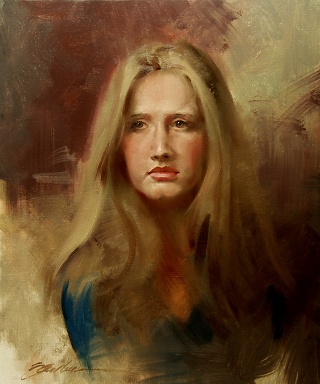|
American Artist Portrait Highlights, October / November
2006
By M. Stephen Doherty
 |
Step-by-Step
Demonstration
Portrait of
Pam McMahon
Step 1 | 2
| 3 | 4
| 5 | 6
| 7 | 8 |
|
|
Standard Colors
ultramarine blue
cerulean blue
viridian
chromium oxide green
alizarin crimson
burnt umber
burnt sienna
cadmium orange
Venetian red
cadmium red light
yellow ochre
cadmium yellow light
ivory black
Permalba white
Neutrals: Sanden uses three values of neutral mixtures
made from combinations of Permalba white, ivory black,
and yellow ochre.
Darks: Two dark values made from combinations of
burnt sienna, viridian, and cadmium orange.
Halftones: One cool halftone used for painting
receding planes achieved by mixing Permalba white, yellow
ochre, cadmium red light, chromium oxide green, and cadmium
orange; and a second halftone for painting the transition
between light and shadow areas made by mixing Permalba
white, yellow ochre, cadmium red light, and viridian.
Lights: Sanden recommends working with three light
values, the first a clear color for
the lightest lights made from a combination of Permalba
white, yellow ochre, and cadmium red light; a second basic
flesh tone developed with Permalba white, yellow ochre,
cadmium red light, and cerulean blue; and a third pinkish
flesh color for ruddy areas in light mixed from Perm alba
white, yellow ochre, cadmium red light, and cerulean blue.
Sanden emphasizes that the Pro Mix Color System colors
are almost never used straight from the tube but are adjusted
with additions from the standard colors or another Pro
Mix color based on observation of the subject. Each set
includes a 20-page instructional booklet. |
|
|

